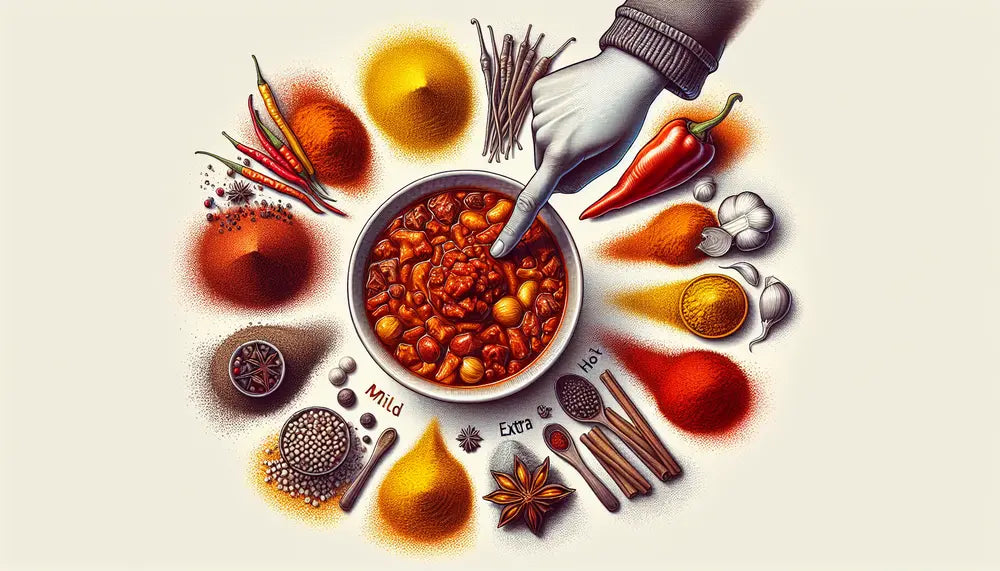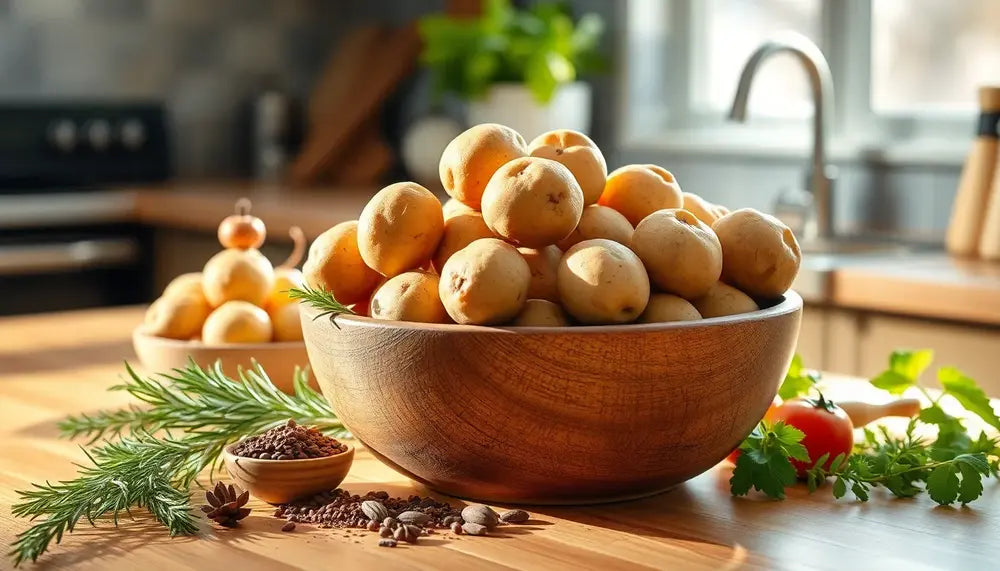The basics: What makes a chili con carne
Chili con carne, literally translated as "chilli with meat", is a popular dish that is prepared in numerous variations around the world. Form the heart of every chili con carnes high quality meat, mostly beef, and of course the Chili peppers. This combination is complemented by a selection of aromatic spices and other ingredients such as Beans and tomatoes, which turn the dish into a rich stew.
The quality and mix of spices used are crucial for the taste. A good chili con carne is characterized by a balanced balance between heat, spice and the individual flavor components. The chili peppers and spices used influence not only the spiciness, but also the depth and complexity of the aroma.
Another key element for an authentic chili con carne is the cooking time. Traditionally it is cooked slowly to allow the flavors of the ingredients to fully develop and combine. The consistency of the stew should be rather thick and the ingredients must harmonize well with each other.
Spices in detail: The basis for an aromatic chili
The careful selection and combination of spices is the secret behind a tasty chili con carne. A classic among spices is Cumin, which characterizes the typical chili taste with its nutty, warm aroma. Without cumin, the dish lacks its characteristic note.
Ground coriander complements this with a slightly citrusy sweetness, while Oregano provides a hearty depth. Garlic powder and Onion powder are also frequently used spices that provide a strong, round aroma. In addition to fresh or dried chili peppers, spices such as: Cayenne pepper and different types of Paprika powder responsible.
The intensity and type of spiciness can vary - from a warm, pleasant tingling sensation to a challenging, burning spiciness that is only suitable for hard-core people. The combination of these spices, tailored to individual taste preferences, makes each chili con carne a more distinctive experience.
| spice | Flavor note | Level of spiciness |
|---|---|---|
| Cumin | nutty-warm | mild |
| Cayenne pepper | strong-sharp | high |
| Paprika powder | sweet-smoky | variable |
| Oregano | hearty | mild |
| Garlic powder | strong | mild |
It's worth experimenting with these and other spices to achieve this perfect taste experience to create. A pinch of love and patience rounds off the spice adventure when preparing the chili.
Mild, medium or fiery: adjust the level of spiciness correctly
The correct dosage of spiciness is crucial Chilli con carne to suit your own taste and that of your guests. A distinction is made between different levels of spiciness: mild, medium and fiery, which are mainly determined by the use of chili and hot peppers. It should be noted that chilies have different concentrations of capsaicin, the substance that is responsible for their spiciness.
When cooking, never add the entire amount of spice at once. Add the hot spices gradually and taste the dish regularly. This is how you find them perfect balancethat pleases every palate. Keep in mind that the spiciness becomes more intense after cooking and can increase as the chili warms up.
- Mild spiciness: Suitable for beginners and those who like things spicy but not too hot. Here, small amounts of mild paprika powder and a pinch of cayenne are often enough.
- Medium level of spiciness: For those who like it a little more fiery. A moderate amount of fresh chilies or a teaspoon of cayenne pepper will help achieve this level.
- High level of spiciness: For real sharpness lovers. It can be more here, but you need to be careful not to overpower the taste of the chili.
The dosage can also be reduced by adding ingredients with fat content such as cream or cheese, as fat binds capsaicin. So experiment carefully and find your personal one Level of spiciness for the ideal chili experience!
Cumin and Co.: Indispensable spices for your chili
Some spices are so essential for preparing an authentic chili con carne that they should not be missing from any recipe. In addition to the already mentioned cumin, other spices also play a central role in the distinctive taste of the dish.
- Cumin (Cuminum cyminum) gives the chili con carne an earthy base note.
- Marjoram provides additional depth of flavor with its spicy-sweet aroma.
- Thyme Brings a pleasant spice into play with its bitter note.
- Bay leaves Add their balsamic scent to the flavor profile and are removed before serving.
These spices complement each other and help the chili con carne develop a full-bodied, complex flavor. When it comes to bay leaf, it should be noted that it is a rather dominant spice and should be used sparingly. One or two leaves are enough for the typical taste without masking the other aromas.
Tip: To fully enjoy the aroma of the spices, you can before Roast briefly in a dry pan before adding to the chili. This is how the oils develop and the aroma intensifies.
Paprika and cayenne pepper: A duo for color and spiciness
When it comes to the look and the fire kick in your chili con carne, form Paprika and Cayenne pepper a perfect team. Paprika gives the chili a bright red color and a sweet to smoky note, depending on whether you choose sweet, hot or smoked paprika. Cayenne pepper on the other hand, brings the heat and spiciness that is expected in this dish.
These two spices can be combined excellently to precisely adjust both the desired spiciness and the color of the chili. Paprika powder is available in different versions:
- Sweet paprika powder provides a mild spice and a rich red color.
- Hot paprika powder increases the level of spiciness without the sudden intensity of the cayenne pepper.
- Smoked paprika powder gives a special smoky note that goes particularly well with meat dishes.
Thanks to cayenne pepper, the spiciness can be controlled specifically - a pinch can be enough to achieve a subtle spiciness, while a larger amount brings the chili up to temperature.
Important: When seasoning, always remember that the individual flavor elements should influence each other and create harmony. A chili that is too hot will mask the subtle flavors of the other spices.
The combination of Paprika and cayenne pepper not only supports the taste, but also appeals to the eye, because as the saying goes: "The eye eats with you!" This is how your chili con carne becomes a delight and Eye candy.
Cocoa powder and cinnamon: secret ingredients for depth of taste
In addition to the classic spicy and spicy components Cocoa powder and Cinnamon a surprising but excellent way to add a special touch to your chili con carne. Both ingredients are known for their use in sweet dishes, but their complex flavor profiles can also add unexpected depth to savory dishes.
Cocoa powder, especially in the unsweetened and dark variety, adds a slightly bitter note and a rich color. When combined with chilies, it can add a subtle but noticeable complexity to the dish.
Cinnamon, usually associated with warm, sweet foods, can be used in small doses to weave its warm, slightly sweet tones into the flavor of a chili without being overpowering. These spices are perfect for the chili that certain something to lend.
Note: Both spices should rather economical be used to fully exploit their potential as a flavor enhancer without drowning out the characteristic chili taste. Half a teaspoon of cinnamon and a teaspoon of cocoa powder in a large pot of chili should be enough.
Tip: To distribute the ingredients evenly and avoid lumps, mix the cocoa powder and cinnamon with a small amount of the cooking water and then add it to the chili.
Individual touch: Additional spices for your personal recipe
Although the aforementioned spices such as cumin or paprika powder are essential, there are other flavors with which you can personalize your chili con carne. Creating your own spice blend means using different herbs and spices to experiment to create a unique flavor profile.
- Oregano adds a tart, spicy note that goes well with the tomatoes in the chili.
- smoked salt or smoked paprika gives the dish a smoky depth that is reminiscent of open fires and rustic cuisine.
- Coriander, fresh or ground, offers a fresh citrus note that balances the heaviness of the chili.
- Chipotle chilies Adobo sauce brings both heat and a smoky sweetness.
Any expansion of the spice range should still be considered and in dimensions in order not to disturb the interaction of the aromas. A pinch here and a touch there can make all the difference and take your chili to the next level. In addition to dry spices, fresh coriander can also be added at the end of cooking to give the dish a fresh touch.
Please note: Spices develop their aroma differently over time. A freshly prepared chili often has an even more intense taste experience the next day.
There's nothing wrong with trying out your own favorite spices and observing their influence on the end result. This is the art of cooking and transforms every dish into a personal creation.
Homemade spice mix: recipe for chili con carne
Creating your own spice mix for chili con carne is not only easy, it also allows you to find the perfect mix for your taste. Here we provide you with a basic recipe for one own spice mix which you can customize as you wish.
| ingredient | quantity |
|---|---|
| Sweet paprika powder | 3 tsp |
| Cumin, ground | 2 tsp |
| Oregano, dried | 2 tsp |
| Garlic powder | 1 tsp |
| Onion powder | 1 tsp |
| Cayenne pepper | to taste |
- Place all ingredients in a bowl.
- Mix the spices thoroughly to obtain a homogeneous mixture.
- Adjust the amount of cayenne pepper to achieve desired spiciness.
- Pour the mixture into airtight Vessel to preserve the aromas.
This spice mixture can be used immediately and is lasts for a few months, provided it is stored in a dry and dark place. You can use the basic recipe as a starting point and experiment with additional spices such as cinnamon or cocoa powder for even more depth in flavor.
Tip: Try it once too Stedy's devilishly hot spice mix from the Online shop for a spicy shortcut.
Storage and shelf life: This is how your spices stay fresh
Proper storage of spices is crucial to preserving their freshness and aroma over a longer period of time. Spices should always be included airtight containers stored to protect them from moisture and air, which significantly extends their shelf life.
The ideal storage is on one cool and shady Place away from direct sunlight or heat sources such as stoves or heaters. This will prevent spices from losing their color and aroma prematurely. The place should also be dry, as moisture can affect the quality and lead to clumping, for example.
- Stuff your spices in airtight jars or special spice containers.
- Avoid storing spices over the stove or near the oven.
- Label the containers with names and dates to keep things organized.
- Different spices have different shelf lives. Ground spices generally last about six until twelve Months, while whole spices up to three Can remain aromatic for years.
Another point is to buy spices in appropriate quantities. Buy smaller quantities that you will use regularly rather than large stocks that could lose flavor before they are used up. For spices that are used less often, it is advisable to buy and share them with friends or relatives.
Awareness of proper storage and handling of expiration dates ensure that your spices always fresh and intense in taste stay · and the next Chili con Carne is guaranteed to be a success.
Buying spices: tips for quality and selection
Choosing high-quality spices is of great importance in order to achieve the best possible results in the kitchen. To buy good quality spices, you should freshness, Origin and Processing be respected.
It is best to buy spices in smaller quantities and from trustworthy retailers who guarantee regular sales and therefore fresh goods. Prefer spices that untreated and are without additives. Organic certified spices often provide a good indication of quality.
- Check that Appearance of spices: you should lively in color and free be of impurities.
- Smell the spices to make sure they are a strong one, characteristic scent have.
- Take these into account Packaging, as spices stored in clear containers could be damaged by light.
- Find out about them Harvest and Expiry dates, if these are available.
When shopping online, pay attention to customer reviews and recommendations. This way you can incorporate the experiences of other buyers into your own purchasing decision. A visit to a specialist shop can also be worthwhile, as they often offer advice and you have the opportunity to inspect the spices directly.
Recommendation: Discover the Spice mixtures from Stedyto rely on proven quality for your next chili con carne.
Conclusion: The perfect spice experience for your chili con carne
The art of creating an outstanding chili con carne lies in the choice and combination of spices. With a deep understanding of the different flavor profiles and Levels of spiciness of the ingredients you can create a taste experience that exactly suits your preferences.
The main actors like Cumin, Paprika and Cayenne pepper provide the basic structure, while spices like Cocoa powder and Cinnamon can add an extra dimension. Experimenting with spice blends and paying attention to proper storage will help ensure that every spoonful of your chili will provide both a gustatory and visual delight.
Also think about the quality of the spices, as this plays an essential role in the final result. By shopping consciously and, if necessary, relying on proven providers such as Stedy leave, make sure your chili con carne is remembered.
Finally, it is important to mention that a successful chili con carne is not only brought to life by the spices, but also by the Attention to detail and the Enjoy cooking. Whether for a cozy evening alone, with family or friends - a well-seasoned, lovingly prepared chili con carne is always a good choice.
FAQ: The ideal seasoning for chili con carne
Which basic spices are essential for a traditional chili con carne?
The base spices in a traditional chili con carne include cumin, for the earthy base flavor, and various types of paprika powder for color and flavor. Cayenne pepper or chili powder provides spiciness, while garlic and onion powder provide a strong flavor base.
How do I achieve different levels of spiciness in my chili con carne?
Depending on the desired intensity, you can vary the amount of hot spices such as cayenne pepper and chili powder. Start with a small amount and gradually increase to increase spiciness. For mild chili, just a pinch is enough, while for fiery chili, add more. Be sure to add the spices gradually throughout the cooking process to better control the spiciness.
Can cocoa powder really improve the depth of flavor in my chili con carne?
Yes, cocoa powder - ideally in an unsweetened, dark form - gives the chili a rich, slightly bitter note and can enhance the flavor complexity of the dish. The recommended amount is about a teaspoon per large pot of chili. It should be noted that cocoa powder should be used sparingly so as not to dominate the spice mixture.
How long do homemade spice mixes last?
Homemade spice mixes can retain their flavors for several months if stored in an airtight container and stored in a cool, dry place. Ground spices generally lose intensity after about six to twelve months, while whole spices can last up to three years.
Which unusual spices can give my chili con carne a special touch?
For an individual touch, you can experiment with spices such as cinnamon, for a sweet warmth, or smoked paprika for a smoky note. Fresh herbs like coriander at the end of cooking or a pinch of cardamom can also add surprising and pleasant flavors.





Share:
Pumpkin mashed potatoes
Optimal selection: Order spices online and enjoy